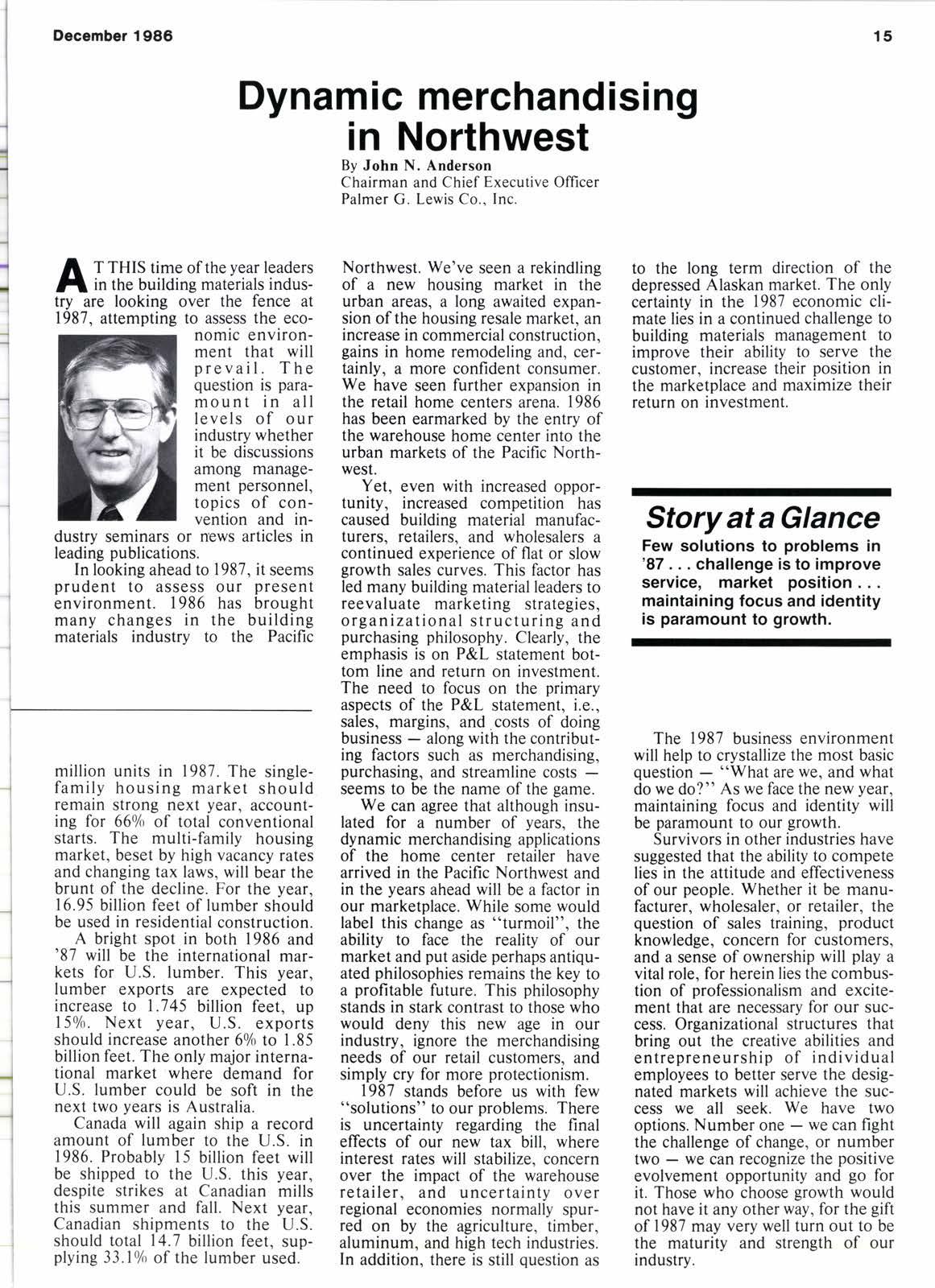
3 minute read
Dynamic merchandising in Northwest
By John N. Anderson Chairman and Chief Executive Officer Palmer G. Lewis Co., Inc.
T THIS time of the year leaders in the building materials industry are looking over the fence at 1987, attempting to assess the economic environment that will prevail. The question is paramount in all levels of our industry whether it be discussions among management personnel, topics of convention and industry seminars or news articles in leading publications.
In looking ahead to 1987, it seems prudent to assess our present environment. 1986 has brought many changes in the building materials industry to the Pacific to the long term direction of the depressed Alaskan market. The only certainty in the 1987 economic climate lies in a continued challenge to building materials management to improve their ability to serve the customer, increase their position in the marketplace and maximize their return on investment, million units in 1987. The single- family housing market should remain strong next year, accounting for 660/o of total conventional starts. The multi-family housing market, beset by high vacancy rates and changing tax laws, will bear the brunt of the decline. For the year, 16.95 billion feet of lumber should be used in residential construction.
Northwest. We've seen a rekindling of a new housing market in the urban areas, a long awaited expansion of the housing resale market, an increase in commercial construction, gains in home remodeling and, certainly, a more confident consumer. We have seen further expansion in the retail home centers arena. 1986 has been earmarked by the entry of the warehouse home center into the urban markets of the Pacific Northwest.
A bright spot in both 1986 and '87 will be the international markets for U.S. lumber. This year, lumber exports are expected to increase to 1.7 45 billion feet, up l5o/0. Next year, U.S. exports should increase another 60/o to 1.85 billion feet. The only major international market where demand for U.S. lumber could be soft in the next two years is Australia.
Canada will again ship a record amount of lumber to the U.S. in 1986. Probably l5 billion feet will be shipped to the U.S. this year, despite strikes at Canadian mills this summer and fall. Next year, Canadian shipments to the U.S. should Lotal 14.7 billion feet, supplying 33.10/o of the lumber used.
Yet, even with increased opportunity, increased competition has caused building material manufacturers, retailers, and wholesalers a continued experience of flat or slow growth sales curves. This factor has led many building material leaders to reevaluate marketing strategies, organizational structuring and purchasing philosophy. Clearly, the emphasis is on P&L statement bottom line and return on investment. The need to focus on the primary aspects of the P&L statement, i.e., sales, margins, and.costs of doing business - along with the contributing factors such as merchandising, purchasing, and streamline costsseems to be the name of the game.
We can agree that although insulated for a number of years, the dynamic merchandising applications of the home center retailer have arrived in the Pacific Northwest and in the years ahead will be a factor in our marketplace. While some would label this change as "turmoil", the ability to face the reality of our market and put aside perhaps antiquated philosophies remains the key to a profitable future. This philosophy stands in stark contrast to those who would deny this new age in our industry, ignore the merchandising needs of our retail customers, and simply cry for more protectionism.
1987 stands before us with few "solutions" to our problems. There is uncertainty regarding the final effects of our new tax bill, where interest rates will stabilize, concern over the impact of the warehouse retailer, and uncertainty over regional economies normally spurred on by the agriculture, timber, aluminum, and high tech industries. In addition, there is still question as
Story at a Glance
Few solutlons to problems in '97 challenge is to improve service, market position . . maintaining focus and identity is paramount to growth.
The 1987 business environment will help to crystallize the most basic question"What are we, and what do we do?" As we face the new year, maintaining focus and identity will be paramount to our growth.
Survivors in other industries have suggested that the ability to compete lies in the attitude and effectiveness of our people. Whether it be manufacturer, wholesaler, or retailer, the question of sales training, product knowledge, concern for customers, and a sense of ownership will play a vital role, for herein lies the combustion of professionalism and excitement that are necessary for our success. Organizational structures that bring out the creative abilities and entrepreneurship of individual employees to better serve the designated markets will achieve the success we all seek. We have two options. Number onewe can fight the challenge of change, or number twowe can recognize the positive evolvement opportunity and go for it. Those who choose growth would not have it any other way, for the gift of 1987 may very well turn out to be the maturity and strength of our industry.










